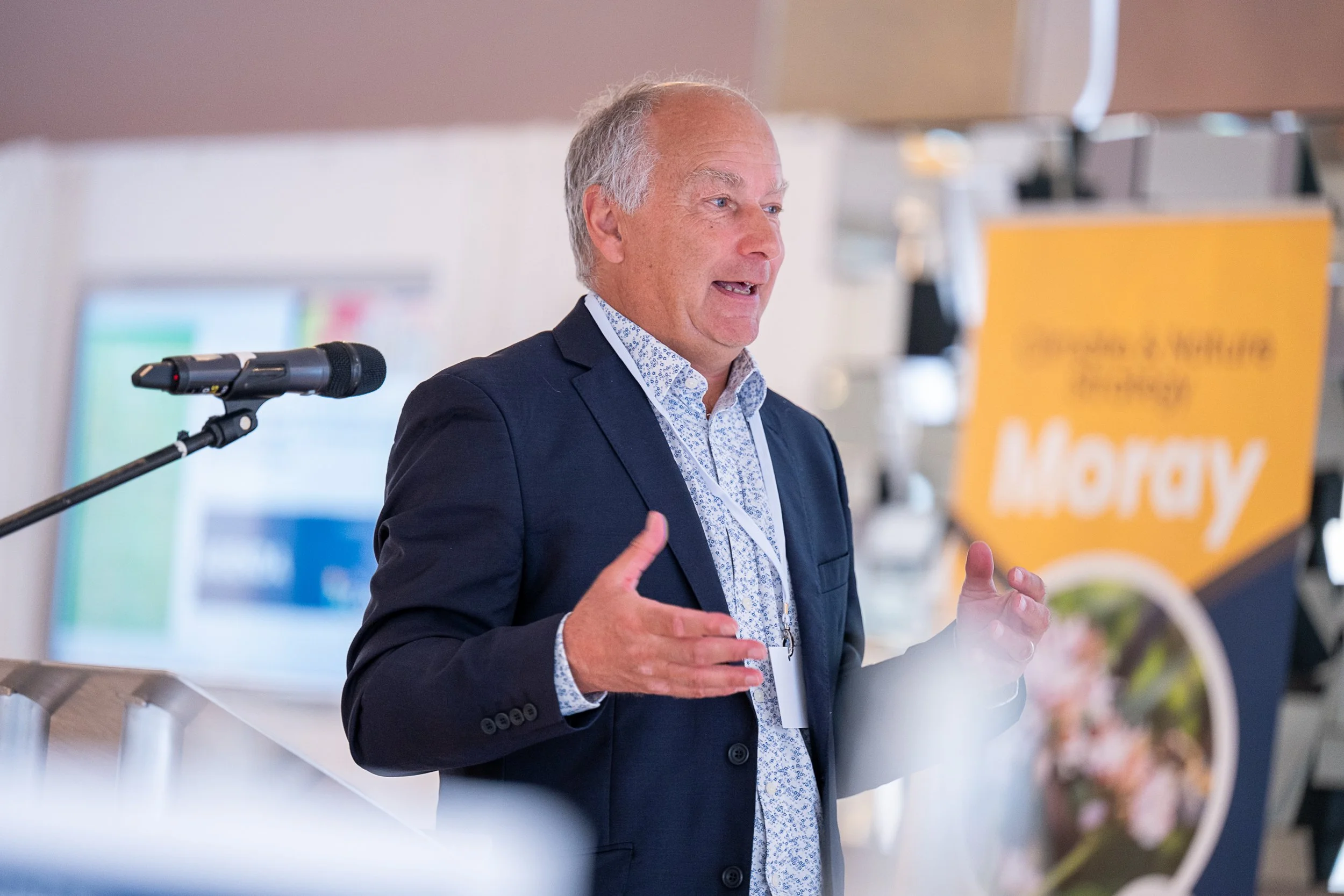Moray’s Climate Conference 2025 Highlights


















Photos by Alexander Williamson
As part of Scotland’s Climate Week the Moray CAN Climate Conference brought together community members, scientists, researchers, youth voices, and local organisations to explore urgent climate issues and local solutions. The day was filled with powerful insights, collaborative energy and a shared commitment to climate action in Moray.
Panellists: Grace Green, Ollie Myrvang-McAvoy, Elsa Bethell, Erynn Crombie
A vibrant youth panel brought fresh perspectives and asked thoughtful, challenging questions… often saying what many of us were thinking. They powerfully articulated the deep interconnections between climate change and broader social and economic issues. Their contributions served as a compelling reminder that the future lies with them, and that taking climate action requires not only urgency but inclusive dialogue.
Keynote: Professor Peter Stott, MBE
Renowned climate scientist and author of Hot Air, Professor Peter Stott opened the day with a compelling keynote. He emphasised the importance of communicating facts over misinformation, reminding us that science must lead the way in climate conversations. He gave us the facts — the rise in global temperatures, even the stats for Moray, including what this summer’s heat really looked like.
We know it, but seeing it laid out so clearly was a powerful reminder of the urgency. While the situation is serious, he reassured attendees that all is not lost — but now is the time to act. To avoid the worst impacts of climate change, we still have time, but we must move faster. Our keynote speaker reminded us that the facts are clear, the urgency is real, and the solutions must also be very much local.
Peter Stott addressing Moray CAN climate conference.
Can Moray Feed Moray: Local Food Systems & Research
Moray CAN shared findings from newly commissioned research exploring whether Moray, as a region, could feed itself. Farmer, economist and co author of the report, Can Moray Feed Moray?, Jo Hunt, showed the numbers behind the research. Early results are promising, suggesting that a more localised food system is possible. A striking example came from Jo’s story of locally grown carrots that travel 912 food miles before returning to Moray — highlighting the need for more sustainable, local supply chains.
Jo Hunt, co-author of the report: Can Moray Feed Moray?
Film Screening: Behind the Bins
A specially commissioned film by Alexander Williamson, Behind the Bins, was screened during the conference. The documentary explores where Moray’s waste goes, following its journey from Council facilities to local social enterprises like Moray Reach Out, Reboot, and Moray Wastebusters. It’s a powerful look at how waste our waste is managed and how it can be transformed into opportunity and community impact. Understanding where our waste goes informs our choices to what we buy and what we throw away.
Tracking Biodiversity in Moray
Alison Rose, from the Whale and Dolphin Conservation charity and centre manager of its flagship Scottish Dolphin Centre, showcased their Shorewatch programme, which is collecting vital data on how climate change is affecting whale and dolphin populations. This citizen science initiative is helping track species movement and environmental shifts, demonstrating the power of community-led research. Alison demonstrated how this citizen science offers a credible and accessible way for individuals to actively contribute to climate action. The data collected through Shore Watch has been sustained over a considerable time, and is now playing a a vital role in informing evidence-based decisions about the management of marine environments with respect to species such as whales and dolphins.
We also heard from John Gifford from the Moray Beekeepers’ Association about the important role beekeeping can play in supporting ecosystems. However, he also acknowledged the serious challenges posed by disease and declining biodiversity, which are endangering bee populations and the broader ecological balance.
Alison Rose, Scottish Dolphin Centre, shares the impact of their Shore Watch programme.
Coastal Erosion & Community Collaboration
Will Burnish, Senior Engineer at Moray Council, spoke about the growing challenge of coastal erosion in Moray. He updated on a number of local projects addressing the situation, including the shingle ridge at Kingston and the Christmas trees at Lossiemouth Beach. Will also gave the critical thinking behind when measures are put in place. He stressed that working with communities is essential, especially when resources are limited. His presentation highlighted the importance of longer-term, locally driven strategies.
Will Burnish, Senor Engineer, Moray Council
Just Transition - What’s needed to transition a workforce from Oil & Gas
The conference also addressed Just Transition — with the focus of the workforce, and how to ensure workers in the oil and gas industries aren’t left behind. David Blair from Moray Trades Union Council raised concerns about the lack of workforce represtation from oil and gas workers and how they are at risk of being excluded from this transition. Dr. Kerry McInnes from UHI Moray shared insights from their Just Transition project, which is shaping curriculum to meet the skills needed for green jobs.
Dr. Kerry McInnes, Just Transition Project, UHI Moray.
David Blair, Moray Trades Union Council
James Crombie - Artist
We were also pleased to showcase an art installation by James Crombie, which powerfully illustrated the systemic economic changes needed to achieve climate action. His piece stresses not only the environmental but also the human cost of inaction — all while a symbolic glacier melted in the background, serving as a poignant call for critical thinking, and urgent reflection on our collective future.
James Crombie
What’s Next - Moray CAN
Throughout the day, Louise Nicol shared updates on Moray CAN’s work over the past year — from funding projects and community growing networks to further community engagement with Buckie Thistle Football Club.
The day concluded with a call for everyone to contribute to Moray’s Climate and Nature Strategy. The process has begun; now it needs your voice, your ideas and your involvement.












